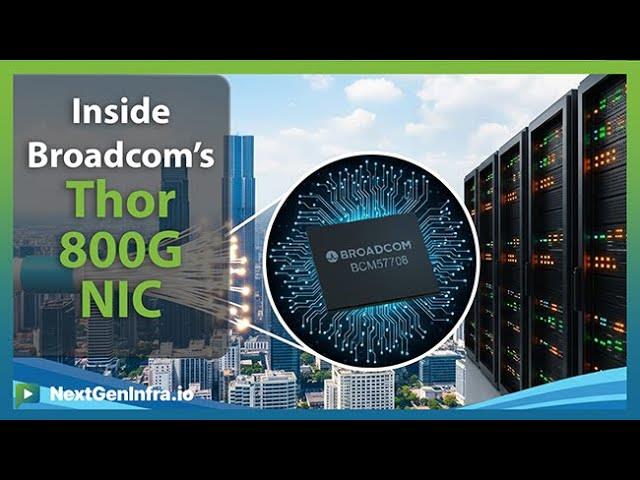
Broadcom Sets New AI Network Benchmark With 800G“Thor Ultra” NIC

Semiconductor giant Broadcom Inc. on 14 October 2025 launched its first 800 gigabit-per-second AI Ethernet Network Interface Card named the“Thor Ultra”, a product the company says enables interconnection of hundreds of thousands of XPUs and supports trillion-parameter artificial-intelligence workloads.
Broadcom describes Thor Ultra as the“industry's first 800G AI Ethernet NIC” that adheres fully to the open standard of the Ultra Ethernet Consortium. The card supports a PCIe Gen6 x16 host interface, 100 G or 200 G PAM-4 SerDes, and features line-rate encryption and decryption, secure-boot firmware and device-attestation.
One of the technological advancements Broadcom highlights is a new RDMA engine re-designed for scale-out AI fabrics, featuring packet-level multipathing, out-of-order packet delivery to XPU memory, selective retransmissions and programmable congestion-control. These additions are intended to overcome performance limitations in traditional RDMA when applied to large-scale AI clusters.
The timing of this launch aligns with Broadcom's wider push into AI infrastructure. The company has simultaneously unveiled roadmap advances in its Tomahawk 6 switch series and has a multi-year strategic collaboration with OpenAI to supply custom accelerators starting in 2026. Analysts view this NIC as a clear signal that networking hardware is becoming a critical enabler of large-model AI deployments, and that Broadcom aims to position itself not just as a traditional switch/adapter vendor but as a platform supplier for next-generation AI datacentres.
Market watchers observe that while Broadcom's core business remains strong, the company faces competitive pressure from NVIDIA Corporation and other firms expanding into network-acceleration and topology optimisation for AI workloads. Reuters notes that the Thor Ultra launch deepens Broadcom's rivalry with NVIDIA in the data-centre networking space.
See also Unconventional Approaches to AI Prompt Engineering Boost AccuracyBroadcom's official statement quotes Ram Velaga, senior vice-president and general-manager of its Core Switching Group, stating:“Thor Ultra delivers on the vision of Ultra Ethernet Consortium for modernising RDMA for large AI clusters.” Ecosystem partners such as Arista Networks and Supermicro have issued supportive comments, indicating that the NIC will be integrated into platforms used for hyperscale GPU-dense systems.
Technical reviewers note certain caveats. The product is currently in a sampling phase rather than full production release, meaning time remains before widespread deployment and real-world performance metrics become available. Costs, power levels and integration complexity for such ultra-high bandwidth devices may restrict initial adoption to hyperscale cloud providers rather than enterprise datacentres. One evaluation points out that the card will be used primarily in scale-out deployments connecting large clusters of XPUs across racks, not for intra-rack GPU interconnects dominated by NVLink or other specialist fabrics.
Analysts estimate the move could open a multi-billion-dollar incremental opportunity. One investor commentary suggests Broadcom's AI networking efforts aim at a total addressable market of between US$60 billion and US$90 billion by 2027.
Industry context shows that as AI models grow in size and complexity-moving from billions of parameters to trillions-the supporting infrastructure must scale accordingly. Traditional Ethernet and RDMA systems increasingly become bottlenecks; hence vendors like Broadcom are re-engineering network interfaces for both higher speeds and smarter traffic handling.
From a data-centre operator perspective, the appeal of an open-standard NIC ecosystem is significant. By aligning with UEC and avoiding proprietary vendor lock-in, Broadcom offers customers the flexibility to mix switches, optics and accelerators from multiple vendors while still achieving high performance. Analysts say this openness may drive faster adoption among hyperscalers seeking to deploy large-scale AI clusters with economies of scale.
See also EDGE's Space Roadshow Ignites Emirati Youth AmbitionYet, integration risk remains. Deploying an 800 G NIC implies upstream support from switches, firmware, operating systems and thermal/power infrastructures. Infrastructure teams must verify that host boards, chassis cooling, and cabling can support the new card's demands. Market commentary emphasises that until those ecosystems mature, full benefit of Thor Ultra may be limited to early-adopter environments.
In sum, Broadcom's Thor Ultra marks a significant step in AI-era networking hardware by combining ultra-high bandwidth, advanced RDMA capabilities and open-ecosystem support for hyperscale AI deployments. Its impact will depend on real-world adoption, integration costs and how competing vendors respond.
Notice an issue? Arabian Post strives to deliver the most accurate and reliable information to its readers. If you believe you have identified an error or inconsistency in this article, please don't hesitate to contact our editorial team at editor[at]thearabianpost[dot]com. We are committed to promptly addressing any concerns and ensuring the highest level of journalistic integrity.
Legal Disclaimer:
MENAFN provides the
information “as is” without warranty of any kind. We do not accept
any responsibility or liability for the accuracy, content, images,
videos, licenses, completeness, legality, or reliability of the information
contained in this article. If you have any complaints or copyright
issues related to this article, kindly contact the provider above.


















Comments
No comment